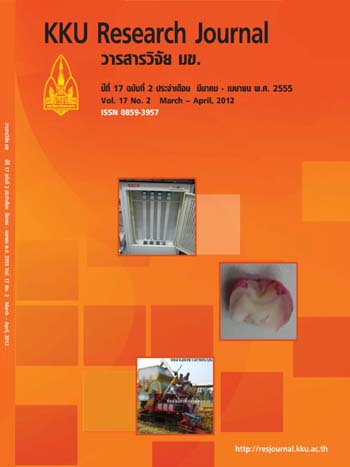Effects of using fermented cassava peel as an energy and fiber sources in diets on growth performance and carcass quality in the tropical finishing lambs
Main Article Content
Abstract
This study was conducted to examine the effects of using fermented cassava peel (FCP) in total mixed
rations (TMR) of fi nishing lamb. Sixteen crossbreed lambs (Dorper x Native) were allotted into a 2x2 factorial
in randomized complete block design (RCBD). Treatments were T1) 30% FCP +5% rice straw (RS), T2) 40%
FCP + 5% RS, T3) 30% FCP + 10% RS and T4) 40% FCP + 10% RS, respectively. Total mixed ration (TMR)
was provided Ad libitum to all treatments. Lambs were slaughtered at the end of the feeding trial (90 days) for
carcass evaluation. The results showed that dry matter intake was signifi cantly higher in T3 than T2 and T4
(1.39, 1.34, 1.52 and 1.12 kg/ head/d respectively; P<0.01). However, body weight change, average daily gain,
carcass weight, dressing percentage, and carcass components were not signifi cantly different among treatments
(P>0.05). Chemical composition of lamb meat showed that moisture content in T2 was signifi cantly lowest
among treatments (69.30, 64.76, 66.30, and 67.14% respectively; P<0.01) and meat fat percentage in T3 had the
statistically highest among treatments (13.44, 14.13, 19.00 and 14.95% respectively; P<0.01). Textural properties
of raw meat and sensory characteristic evaluation were not signifi cantly different among treatments (P>0.05).
Therefore, the results of experiment suggested that using FCP as energy and fi ber sources in lamb diet can be an
appropriate and might use a level of 30% FCP with 10% RS in TMR.


